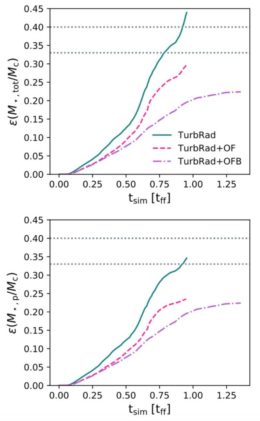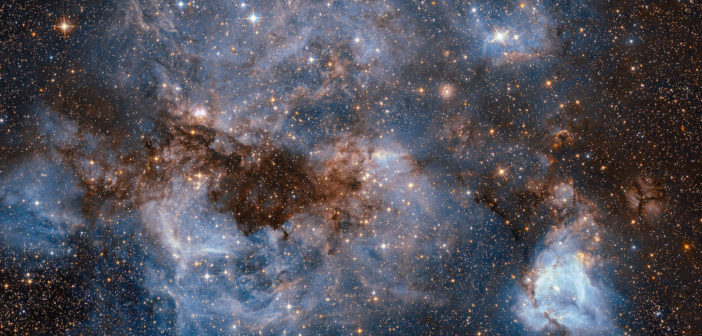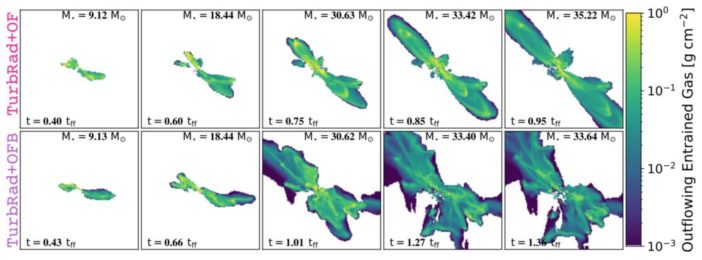Editor’s note: Astrobites is a graduate-student-run organization that digests astrophysical literature for undergraduate students. As part of the partnership between the AAS and astrobites, we occasionally repost astrobites content here at AAS Nova. We hope you enjoy this post from astrobites; the original can be viewed at astrobites.org.
Title: The Role of Outflows, Radiation Pressure, and Magnetic Fields in Massive Star Formation
Authors: Anna Rosen and Mark Krumholz
First Author’s Institution: Center for Astrophysics | Harvard & Smithsonian
Status: Accepted to ApJ

This newly formed star at the heart of the Orion Nebula is blowing a bubble that’s preventing further star formation around it. [NASA/SOFIA/Pabst et al.]
Pushing the Boundaries
The fact that massive stars are so rare is reflective of a more general problem with star formation: its inefficiency. Estimates of star formation efficiencies are as low as 33%. As massive stars begin to form, they launch powerful molecular outflows from their poles. These jets can interact with the surrounding molecular cloud and eject large quantities of material. This, in combination with other feedback mechanisms, limits the star’s ability to accrete material, ultimately limiting its final mass. Knowing the upper limit of just how massive a star can be is incredibly valuable, for it allows us to set the upper boundary of the initial mass function. This function models the initial distribution of stellar masses for a given population of stars, and it is impossible to simulate the evolution of a stellar population without one. This is where massive stars are important, for they are the dominant source of radiative feedback and energy injection into the ISM through supernovae. So, to help determine these upper mass limits, we must simulate the processes that inhibit star formation in as much detail as possible.
Massively Magnetic Outflows Radiation Pressure (Games)
What does an MMORPG like EVE Online have in common with a radiative magnetohydrodynamic simulation? An insane amount of calculations. As the name implies, such a simulation models radiative transfer in addition to magneto-fluid dynamics. The simulation models stellar radiation fields and collimated outflows (the flow is parallel everywhere) for every star, and also factors in the indirect radiative feedback from dust, magnetic fields, and supersonic turbulence. The authors ran three main simulations: TurbRad (radiative feedback only), TurbRad+OF (adds collimated outflows), and TurbRad+OFB (adds magnetic fields).

Figure 1: Density plots for the authors’ three simulations, with the most massive star shown in the center of each panel. [Rosen & Krumholz 2020]
In Figure 1, after the stellar mass of the protostellar core exceeds 30 solar masses, we see several pressure-dominated bubbles expanding away from the star (this is most noticeable in the middle row TurbRad+OF simulation). This process is known as the “flashlight effect”, where thick material is beamed away from the poles, causing low-density bubbles to expand outwards.
Go With The Flow
Over time, strong entrained outflows begin to break through the protostellar core and eject large quantities of material, as can be seen in Figure 2.
The outflows in Figure 2 become steadier and more directed over time. Although the protostellar core is initially highly turbulent, as it accretes material its rotational axis stabilises over time. One of the key results of these simulations is that the momentum feedback from these outflows is the dominant feedback mechanism (compared to radiation pressure) and helps to eject significant fractions of material, reducing the star formation efficiency. Outflows also help to act as conduit through which radiation can escape, weakening the feedback effects from radiation pressure.Don’t Forget the B Field

Figure 3: The star formation efficiencies for the total stellar population (top) and the primary, most massive star (bottom) as functions of simulation time for the three different simulations. [Rosen & Krumholz 2020]
In such an involved phenomena like star formation, there are many nuances. Magnetic fields slow the growth rate of stars by helping to prevent the core from fragmenting, however there are several non-ideal effects (such as the Hall effect) that could theoretically impact the star formation process. These non-ideal effects were not considered, although it is unknown whether such effects have any noticeable impact on star formation efficiencies.
A Joint Effort
This comprehensive series of simulations, one of the first to account for so many factors, demonstrates the role of outflows, magnetic fields and radiation pressure in limiting the formation of massive stars and reducing the overall star formation efficiency. This study shows that feedback from outflows dominates the feedback from radiation pressure, and that magnetic fields further inhibit star formation. Importantly, both outflows and magnetic fields are needed to reproduce the low efficiencies obtained from observations.
About the author, Mitchell Cavanagh:
Mitchell is a PhD student in astrophysics at the University of Western Australia. His research is focused on the applications of machine learning to the study of galaxy formation and evolution. Outside of research, he is an avid bookworm and enjoys gaming, languages, and code jams.



2 Comments
Pingback: Powstawanie masywnych gwiazd – PTMA Kraków
Pingback: Where Do We Come From, Literally? | A Circle Is Round